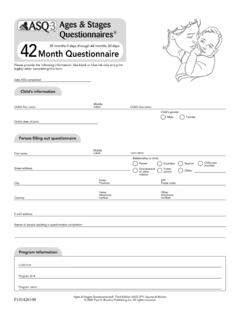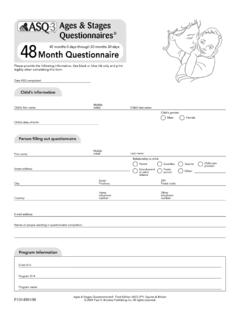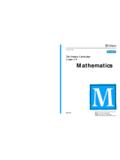Transcription of Ages & Stages Questionnaires 54 Month Questionnaire
1 Ages & Stages Questionnaires , Third Edition (ASQ-3 ),Squires & Bricker 2009 Paul H. Brookes Publishing Co. All rights filling out questionnaireChild s informationDate ASQ completed:Relationship to child:ParentStreet address:Names of people assisting in Questionnaire completion:Grandparent or other relativeGuardianFoster parentTeacherChild care providerOther:Ages & StagesQuestionnaires Month Questionnaire51 months 0 days through 56 months 30 daysPlease provide the following information. Use black or blue ink only and printlegibly when completing this s first name:Child s last name:Child s date of birth:First name:Last name:Middle initial:City:Home telephone number:State/Province:ZIP/Postal code:Other telephone number:E-mail address:Child s gender:MaleFemaleMiddle initial:Country:Program InformationChild ID #:Program ID #:Program name:Ages & Stages Questionnaires , Third Edition (ASQ-3 ),Squires & Bricker 2009 Paul H. Brookes Publishing Co. All rights 2 of 7E101540200 Month Questionnaire54 51 months 0 days through 56 months 30 daysImportant Points to Remember: Try each activity with your child before marking a response.
2 Make completing this Questionnaire a game that is fun foryou and your child. Make sure your child is rested and fed. Please return this Questionnaire by :_____On the following pages are questions about activities children may do. Your child may have already done some of the activitiesdescribed here, and there may be some your child has not begun doing yet. For each item, please fill in the circle that indicateswhether your child is doing the activity regularly, sometimes, or not Does your child tell you at least two things about common objects? Forexample, if you say to your child, Tell me about your ball, does shesay something like, It s round. I throw it. It s big ?2. Does your child use all of the words in a sentence (for example, a, the, am, is, and are ) to make complete sentences, such as Iamgoing to thepark, Isthere atoy to play with? or Areyou com-ing, too? 3. Does your child use endings of words, such as -s, -ed, and -ing ?
3 For example, does your child say things like, I see two cats, I amplaying, or I kickedthe ball ?4. Without giving your child help by pointing or repeating directions,does he follow three directions that are unrelatedto one another? Giveall three directions before your child starts. For example, you may askyour child, Clap your hands, walk to the door, and sit down, or Giveme the pen, open the book, and stand up. 5. Does your child use four- and five-word sentences? For example, doesyour child say, I want the car ? Please write an example:6. When talking about something that already happened, does your childuse words that end in -ed, such as walked, jumped, or played ?Ask your child questions, such as How did you get to the store? ( Wewalked. ) What did you do at your friend s house? ( We played. )Please write an example:YESSOMETIMESNOT YETCOMMUNICATION TOTALAges & Stages Questionnaires , Third Edition (ASQ-3 ),Squires & Bricker 2009 Paul H.
4 Brookes Publishing Co. All rights Month Questionnairepage 3 of 7E101540300 YESSOMETIMESNOT YETGROSS MOTOR TOTALYESSOMETIMESNOT YETGROSS MOTOR1. Does your child hop up and down on either the right foot or the leftfoot at least one time without losing her balance or falling?2. While standing, does your child throw a ball overhandin the direction of a person standing at least 6 feet away? To throw overhand, your child must raise his arm to shoulder height and throw the ball forward. (Dropping the ball or throwing the ball underhand should be scored as not yet. )3. Does your child jump forward a distance of 20 inches from a standingposition, starting with her feet together?4. Does your child catch a large ball with both hands? (You should stand about 5 feet away and give your child two or three tries before you mark the answer.)5. Without holding onto anything, does your child stand on one foot for at least 5 seconds without losing her balance and putting her foot down?
5 (You may give your child two or three tries before you mark the answer.)6. Does your child walk on his tiptoes for 15 feet (about the length of alarge car)? (You may show him how to do this.)FINE MOTOR1. Using the shapes below to look at, does your child copy at least threeshapes onto a large piece of paper using a pencil, crayon, or pen, with-out tracing?(Your child s drawings should look similar to the design ofthe shapes below, but they may be different in size.)2. Does your child unbutton one or more buttons? Your child may use hisown clothing or a doll s Does your child color mostly within the lines in a coloring book orwithin the lines of a 2-inch circle that you draw?(Your child should notgo more than 1 4 inch outside the lines on most of the picture.)FINE MOTOR(continued)4. Ask your child to trace on the line below with a pencil. Does your childtrace on the line without going off the line more than two times?(Mark sometimes if your child goes off the line three times.)
6 5. Ask your child to draw a picture of a person on a blank sheet of may ask your child, Draw a picture of a girl or a boy. If your childdraws a person with head, body, arms, andlegs, mark yes. If yourchild draws a person with only three parts (head, body, arms, or legs),mark sometimes. If your child draws a person with two or fewer parts(head, body, arms, or legs), mark not yet. Be sure to include thesheet of paper with your child s drawing with this Draw a line across a piece of paper. Using child-safe scissors, does your child cut the paper in half on a more or less straight line, making the blades go up and down? (Carefully watch your child s use of scissors for safety reasons.)PROBLEM SOLVING1. When shown objects and asked, What color is this? does your childname five different colors, like red, blue, yellow, orange, black, white,or pink? (Mark yes only if your child answers the question correctlyusing five colors.)2. Does your child dress up and play-act, pretending to be someone orsomething else?
7 For example, your child may dress up in differentclothes and pretend to be a mommy, daddy, brother, sister, or an imag-inary animal or If you place five objects in front of your child, can she count them bysaying, One, two, three, four, five in order? (Ask this question withoutproviding help by pointing, gesturing, or naming.)4. When asked, Which circle is smallest? does your child point to thesmallest circle? (Ask this question withoutproviding help by pointing,gesturing, or looking at the smallest circle.) 5. Does your child count up to 15 without making mistakes? If so, mark yes. If your child counts to 12 without making mistakes, mark some-times. Ages & Stages Questionnaires , Third Edition (ASQ-3 ),Squires & Bricker 2009 Paul H. Brookes Publishing Co. All rights Month Questionnairepage 4 of 7E101540400 YESSOMETIMESNOT YETFINE MOTOR TOTALYESSOMETIMESNOT YETPROBLEM SOLVING(continued)6. Does your child know the names of numbers?
8 (Mark yes if he identi-fies the three numbers below. Mark sometimes if he identifies twonumbers.)312 PERSONAL-SOCIAL1. Does your child wash her hands using soap and water and dry off witha towel without help?2. Does your child tell you the names of two or more playmates, not in-cluding brothers and sisters? (Ask this question without providing helpby suggesting names of playmates or friends.)3. Does your child brush his teeth by putting toothpaste on the tooth-brush and brushing all of his teeth without help? (You may still need tocheck and rebrush your child s teeth.)4. Does your child serve herself, taking food from one container to an-other, using utensils? (For example, does your child use a large spoonto scoop applesauce from a jar into a bowl?)5. Does your child tell you at least four of the following? Please mark theitems your child First named. Last nameb. Agee. Boy or girlc. City he lives inf. Telephone number6. Does your child dress and undress herself, including buttoningmedium-size buttons and zipping front zippers?
9 Ages & Stages Questionnaires , Third Edition (ASQ-3 ),Squires & Bricker 2009 Paul H. Brookes Publishing Co. All rights Month Questionnairepage 5 of 7E101540500 YESSOMETIMESNOT YETPROBLEM SOLVING TOTALYESSOMETIMESNOT YETPERSONAL-SOCIAL TOTALOVERALLP arents and providers may use the space below for additional Do you think your child hears well? If no, explain:YESNOAges & Stages Questionnaires , Third Edition (ASQ-3 ),Squires & Bricker 2009 Paul H. Brookes Publishing Co. All rights Month Questionnairepage 6 of 7E101540600 OVERALL(continued)2. Do you think your child talks like other children her age? If no, explain:3. Can you understand most of what your child says? If no, explain:4. Can other people understand most of what your child says? If no, explain:5. Do you think your child walks, runs, and climbs like other children his age?If no, explain:6. Does either parent have a family history of childhood deafness or hearingimpairment?
10 If yes, explain:7. Do you have any concerns about your child s vision? If yes, explain:YESNOYESNOYESNOYESNOYESNOYESNOAg es & Stages Questionnaires , Third Edition (ASQ-3 ),Squires & Bricker 2009 Paul H. Brookes Publishing Co. All rights Month Questionnairepage 7 of 7E101540700 OVERALL(continued)8. Has your child had any medical problems in the last several months? If yes, explain:9. Do you have any concerns about your child s behavior? If yes, explain:10. Does anything about your child worry you? If yes, explain:YESNOYESNOYESNOAges & Stages Questionnaires , Third Edition (ASQ-3 ),Squires & Bricker 2009 Paul H. Brookes Publishing Co. All rights ASQ SCORE INTERPRETATION AND RECOMMENDATION FOR FOLLOW-UP: You must consider total area scores, overall responses, and other considerations, such as opportunities to practice skills, to determine appropriate follow-up. If the child s total score is in the area, it is above the cutoff, and the child s development appears to be on the child s total score is in the area, it is close to the cutoff.


















